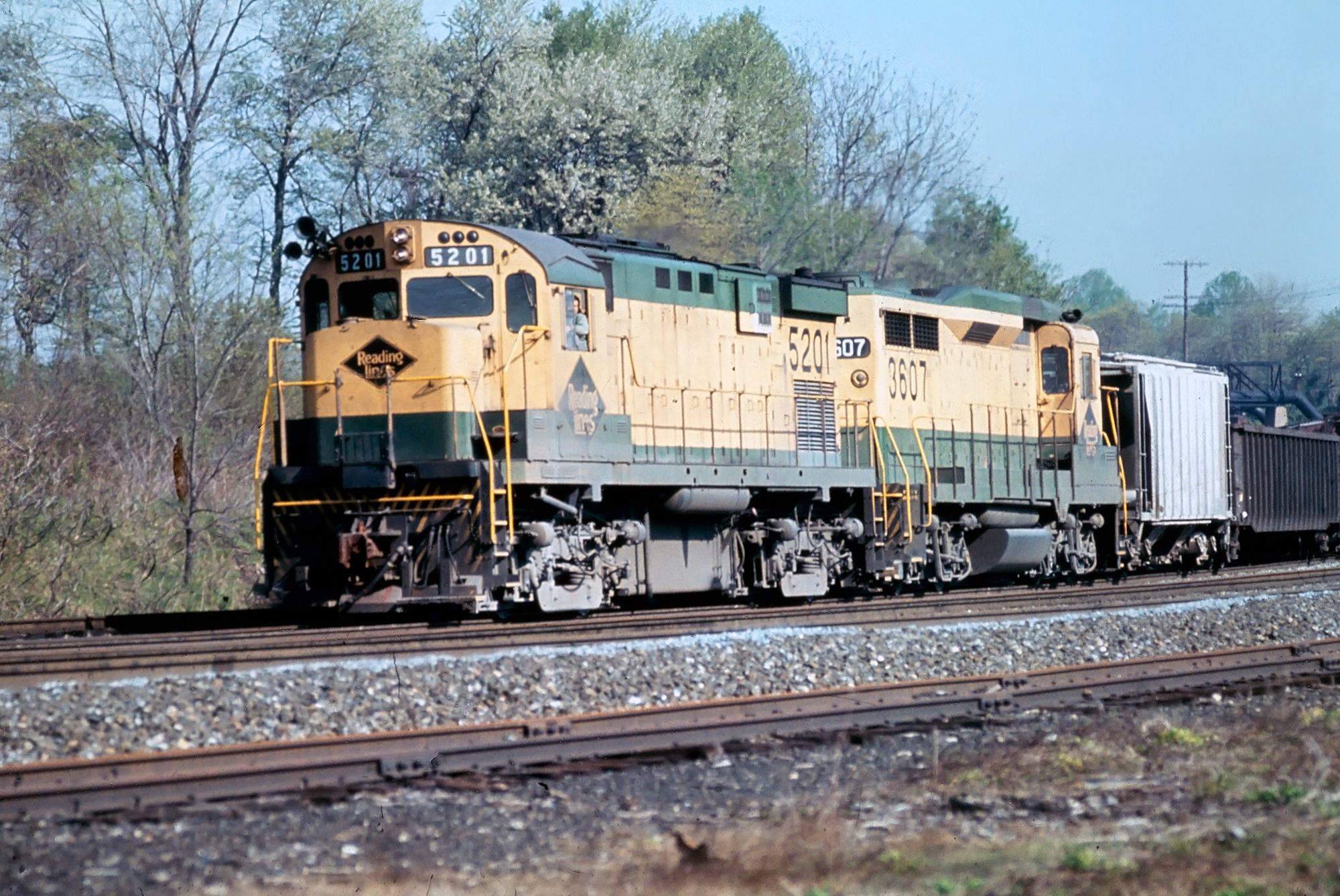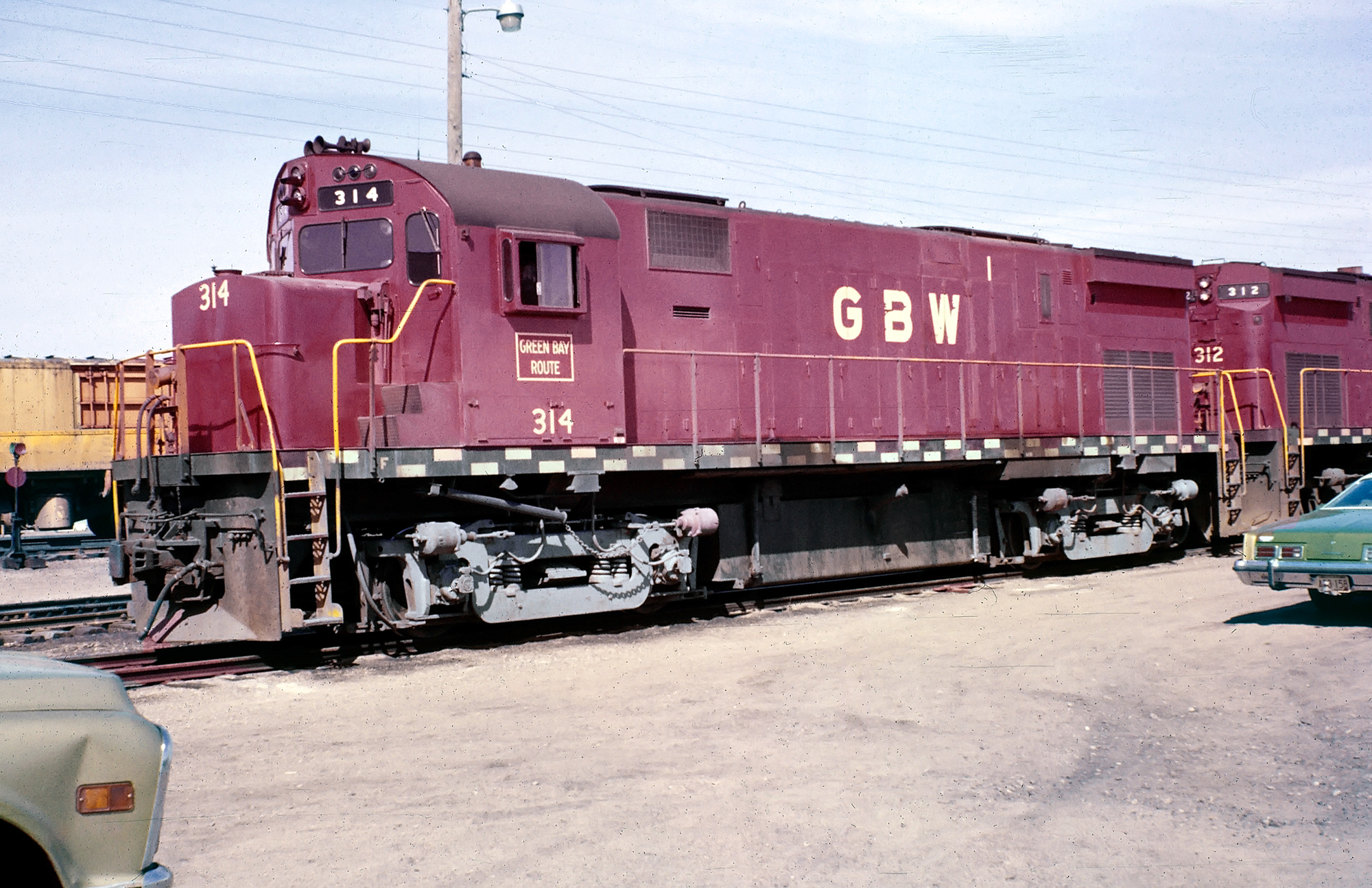Alco "C-424" Locomotives: Data Sheet, Roster, History
Last revised: December 26, 2024
By: Adam Burns
The C424 was Alco's second B-B, four-axle road switcher in the Century series, debuting in 1963 along with its sister model,
the C420.
While sales were modest, it was the best-selling Century design with 190 examples sold in the U.S. and Canada.
Today, the ruggedness and reliability of these locomotives continues to show through as numerous examples of the C424 not only remained preserved but also are still used in freight service across the country.
Some locations where they can still be found hauling freight include the Western New York & Pennsylvania, Morristown & Erie, Buffalo Southern, and the Bath & Hammondsport Railroad.
Photos
 Reading C424 #5201 and GP30 #3607 in freight service; May 6, 1972. Location not recorded. American-Rails.com collection.
Reading C424 #5201 and GP30 #3607 in freight service; May 6, 1972. Location not recorded. American-Rails.com collection.Overview
On the Belt Railway of Chicago the locomotives became a railfan favorite. The terminal road used its small fleet of six (#600-605) from the time they were purchased new from Alco in 1965-1966 until the early 2000's.
The C424 (listed by the builder as its DL640A) began production in 1963 as a replacement for its RS27 line, which had stopped production a year earlier and sold poorly at just 27 units.
Very similar to the RS27 the C424 offered the same horsepower (2,400) and prime mover, Alco's 251B model. The design also closely resembled the RS27 with a flush, long hood and very short front, low hood (giving the unit a somewhat "stubby" appearance).
Alco did away with the notched corners on the C424's carbody, instead giving the nose a simple rounded look and the trailing long hood a raised edge for the number boards. Once again, Alco returned to General Electric for internal components such as traction motors and generators.
Fortunately the C424 sold better than its predecessor as a number of Class I railroads around the country picked up the model.
Additionally, smaller lines also purchased the design including Alco loyalists Green Bay & Western and Erie Mining while the Toledo, Peoria & Western also picked up a few units.
Unfortunately, while Alco sold nearly 200 C424s, 99 were built by the Montreal Locomotive Works for the Canadian Pacific, Canadian National, and Mexican line National de Mexico purchased another 45.
In general, most of the roads that bought the Alco C424 were returning customers, as the company could simply no longer attract new buyers and interest (which was mostly due to the fact that Alco still had a reputation for reliability issues despite having mostly corrected this problem years before).
Production ended on the model in early 1967 and despite the slow sales numbers (in comparison to models being produced by EMD who was selling thousands of GP35s and GP38s) the lines that purchased the C424 were generally quite happy with the models.
For instance, the Reading used theirs in regular freight service until Conrail's creation in the spring of 1976 and the Green Bay & Western and Belt Railway of Chicago both employed theirs for decades before retirement or selling the units.
Additionally, the Canadian Pacific was still finding uses for their MLW M424s into the early 1990s. Today, along with preserved C424s you can still find them being used in freight service on short lines like the Apache Railway and Livonia, Avon & Lakeville.
Unfortunately, the future of those in service on the Arkansas & Missouri is in doubt as the railroad announced in July of 2013 it would be retiring much of its fleet by September after it had purchased three new SD70ACes from EMD.
Data Sheet and Specifications
| Entered Production | 5/1963 (Erie Lackawanna #2401) |
| Years Produced | 5/1963-5/16/1966 |
| Model Specification | DL640A |
| Engine | 251B, V-16 |
| Horsepower | 2,400 |
| RPM | 1,025 |
| Carbody Styling | Alco |
| Length (Between Coupler Pulling Faces) | 59' 4" (Originally 58' 10") |
| Weight | 260,000 Lbs. |
| Dynamic Brakes | Optional |
| Trucks | B-B |
| Truck Type | Swing Bolster, Drop-Side Equalizer (AAR Type-B) |
| Truck Wheelbase | 9' 4" |
| Wheel Size | 40" |
| Traction Motors | GE 752 (4) |
| Traction Generator | GT581 |
| Steam Generator | - |
| Gear Ratio | 65:18 |
| Tractive Effort Rating | 64,200 Lbs. |
| Top Speed | 75 MPH |
Production Roster
Alco
Total Built = 98
| Owner | Road Number(s) | Serial Number(s) | Date Built |
|---|---|---|---|
| Belt Railway of Chicago | 600 - 602 | 3382-05 to 07 | 4/1965 |
| Belt Railway of Chicago | 603 - 605 | 3450-01 to -03 | 4/1966 |
| Erie Lackawanna | 2401 - 2403 | 84543-84545 | 5/1963 |
| Erie Lackawanna | 2404 - 2415 | 84546-84557 | 6/1963 |
| Erie Mining Company | 500 | 3382-03 | 10/1964 |
| Green Bay & Western | 311 | 84559 | 9/1963 |
| Green Bay & Western | 312 | 3375-01 | 6/1964 |
| Green Bay & Western | 313, 314 | 3382-04, -08 | 1/1965, 9/1965 |
| Pennsylvania | 2415 | 84558 | 9/1963 |
| Reading | 5201 - 5203 | 84560-84562 | 10/1963 |
| Reading | 5204 - 5210 | 84733-84739 | 10/1963 - 11/1963 |
| Spokane, Portland & Seattle | 300 - 306 | 6/1964 | |
| Toledo, Peoria & Western | 800 - 801 | 9/1964 | |
| Wabash Railroad | B900 - B902* | 3372-01 to -03 | 3/1964 |
| Wabash Railroad | B903 - B906* | 3372-04 to -07 | 3/1964 |
* The Wabash Railroad's seven C424's, #B900-B906, were originally ordered for the Ferrocarril Nacional de México (NdeM) and expected to become #8000-8006 (construction numbers 3372-1 thru 3372-7).
However, through a lease-purchase contract they were sent to the Wabash and eventually became Norfolk & Western #3900-3906. Afterwards, NdeM acquired seven additional C424's, construction numbers S-3380-1 thru S-3380-7 (#8100-8106).
By this time Alco's construction numbering system had changed from a five-digit number (in sequential order of completion) to a Sales Number along with however many locomotives a customer ordered.
Montreal Locomotive Works
Total Built = 92
| Owner | Road Number(s) | Construction Number(s) | Completion Date |
|---|---|---|---|
| Canadian Pacific | 8300 | 84413 | 4/1963 |
| Canadian National | 3200-3201 | 84837-84838 | 12/1964 |
| Canadian Pacific | 4200-4232 | 84839-84870 | 3/1965-8/1965 |
| Canadian Pacific | 4233-4250 | 3436-01 thru 3436-18 | 12/1965-3/1966 |
| Canadian National | 3202-3205 | 3443-01 thru 3443-04 | 3/1966-5/1966 |
| Canadian National | 3206-3221 | 3444-01 thru 3443-16 | 5/1966-8/1966 |
| Canadian National | 3222-3228 | 3477-01 thru 3477-07 | 1/1967-2/1967 |
| Canadian National | 3229-3240 | 3478-01 thru 3478-12 | 2/1967-5/1967 |
Sources
- Foster, Gerald. A Field Guide To Trains. New York: Houghton Mifflin, 1996.
- Kirkland, John F. Diesel Builders, The: Volume Two, American Locomotive Company And Montreal Locomotive Works. Glendale: Interurban Press, 1989.
- Pinkepank, Jerry A. Diesel Spotter's Guide. Milwaukee: Kalmbach Publishing Company, 1967.
- Solomon, Brian. Alco Locomotives. Minneapolis: Voyageur Press, 2009.
 Green Bay & Western C424's #312 and #314 layover in Wisconsin Rapids, Wisconsin on April 24, 1974. American-Rails.com collection.
Green Bay & Western C424's #312 and #314 layover in Wisconsin Rapids, Wisconsin on April 24, 1974. American-Rails.com collection.Interestingly, it should be noted that during the 1960s General Electric was not selling considerably more locomotives than Alco.
Practically from the start of the diesel locomotive era in the late 1930s, through the early 1980s, EMD was a juggernaut, producing a seemingly endless array of reliable and proficient diesel models during this time, which left little room for the competition.
Contents
Recent Articles
-
Florida Father's Day Train Rides: A Complete Guide
May 09, 25 11:51 AM
For those looking for something a little different this year, why not consider celebrating dad on Father's Day by train? -
Colorado Father's Day Train Rides: A Complete Guide
May 09, 25 11:29 AM
With its rugged mountains, rich railroading history, and picturesque landscapes, Colorado sets the perfect stage for a memorable Father's Day outing aboard a vintage train. -
Arkansas Mother's Day Train Rides: A Complete Guide
May 09, 25 11:22 AM
Celebrate mom aboard one of the finest scenic trains in the country on the Arkansas & Missouri Railroad!


